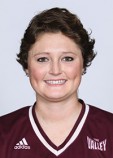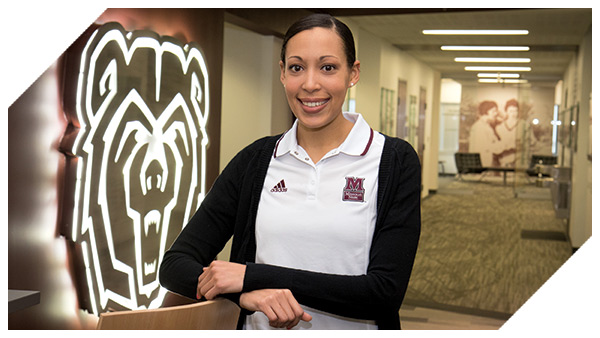In October 2014, the Missouri State community rallied around softball player Allie Alvstad, who had recently been diagnosed with acute myeloid leukemia, a form of blood cancer.
One of the events on campus to support Alvstad was a bone marrow donor registration drive. It involved filling out some paperwork and having a cheek swab.
“I thought, ‘why not?’” said A’dja Jones, ’11 and ’14, an academic counselor in the Dr. Mary Jo Wynn Academic Achievement Center who works with student-athletes. “I had no idea how that one decision would be life-changing.”
Alvstad now back on campus
 Alvstad received a bone marrow transplant from an anonymous donor in December 2014 after two rounds of intense chemotherapy. Her recovery reached a point of success on March 21, 2015, that allowed her to move back to her hometown of Tulsa following a more than three-month stay at the Baylor Medical Center in Dallas.
Alvstad received a bone marrow transplant from an anonymous donor in December 2014 after two rounds of intense chemotherapy. Her recovery reached a point of success on March 21, 2015, that allowed her to move back to her hometown of Tulsa following a more than three-month stay at the Baylor Medical Center in Dallas.
She has since returned to classes at MSU and rejoined the softball team.
As Alvstad’s journey was taking a good turn, Jones’ story was beginning.
Jones is a match; decides to donate
In November 2015, Jones got an email from the Delete Blood Cancer organization indicating she was a match for a patient in need. The email was followed a few days later by a phone call from the organization, which coordinates blood cancer treatment programs across the country.
Jones recalls the call: A little boy with leukemia needed a marrow transplant.
“It took me some time to process it. I have a little sister who just turned 10, and I thought, what if she needed something like this? I also have a cousin who was diagnosed with lymphoma at 9 years old who had gone through a bone marrow transplant. So, it was easier to think of it through their eyes.”
After agreeing to donate, Jones had to undergo a physical at the hospital where the transplant would take place. She was flown to Washington, D.C., to fill out the extensive paperwork, be briefed on the procedure options and have the physical.
Jones was to return Jan. 22 to Washington for surgery to remove bone marrow, and the transplant would be three days later. But winter weather caused flight delays, and the precisely timed transplant was in jeopardy.
She and her mother left Springfield on time, but the flight to D.C. almost didn’t take off.
“The (hospital) kept calling me and telling me – ‘you have to get here. The patient is ready.’”
They got on the last flight into Washington that day, and the procedure was successful.
I can now become an advocate
Back in Springfield for the spring 2016 semester, Jones began to process what happened. Though she had some soreness, “my pain was nothing compared to the suffering that little boy had been through. And I would absolutely do it all again.”
After a year, the boy’s family will have the option to make contact with her. That’s how the donor-recipient relationship works. But she was told he lives outside the U.S., meaning she will likely never meet him in person.
“The one thing I can take away from this experience is I hope I can now become an advocate for more people to be donors. Even if I can inspire one person to do it, that’s awesome.”


Leave a Reply